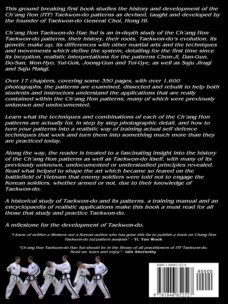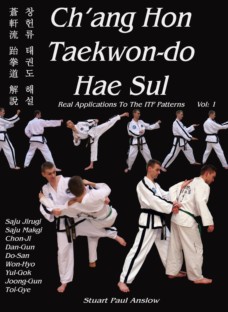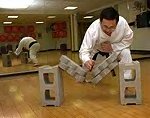Ch'ang Hon Taekwon-do Hae Sul Real Applications To The ITF Patterns Vol: 1 The new book by Stuart Anslow |
Recommended Reading |
Recommended Reading |


Foreword by Yi, Yun Wook I have met many practitioners of various martial arts since I started Taekwon-do some 30+ years ago. I was trained by some of the best of the military Taekwon-do drill instructors under the direct auspices of General Choi, Hong Hi, the founder of Taekwon-do. I realized what Taekwon-do excellence was from these instructors: Solid basic foundations from the beginning. They were found in force flowing in the basic moves; in the tuls (patterns); in choreographed three-step up to multiple attacker free sparring; in hosinsul (self-defense); and destruction techniques. The standardized Taekwon-do curriculum of basics, patterns, sparring, hosinsul, and destruction all carried equal weight. The standardized curriculum were executed by applying the distinct theory of power only Ch’ang Hon Taekwon-do offered. Over the years, things have changed. People opted for getting the next belt with less effort. Riding on the same bandwagon, unscrupulous ”masters” often used quick sales pitch to make profits for this popular martial art called Taekwon-do. The quality instructors decreased as instructors ready-for-profit would forego many basic moves essential for the strong foundation of Taekwon-do. More students flocked to the lesser quality instructors for ease of effort. Excellence in Taekwon-do waned as only ”tag kicking” became the rage in the sports arena and less skilled unscrupulous instructors joined in the foray of self-marketing. The philosophy of these ”masters” of ”why bother teach unnecessary moves that gets in the way of quick profits?” further allowed essential basic techniques to disappear at a horrendous rate. Some ”masters” even made ”absolutely no-contact rules” in Taekwon-do (less insurance, more students, and quick promotion fees). In traditional Taekwon-do, there are at least 7 basic elbow strikes TIMES several angles based on 3 dimensional space and your target. You trained your elbows over and over on different angles and targets, with training equipment and partners. The same training is applied to all the other techniques in Taekwon-Do. The techniques eventually became part of your survival instinct; the true essence of the martial art. The effectiveness of this type of training proved itself during the Vietnam War. Even 3rd degree black belts and higher ranks in watered down Taekwon-do nowadays would not know how and when to apply what elbow strikes. Or worse, come to realize “that many” elbow strikes or target practice training regimen for each different elbow strike, even existed. Another disconcerting point in present day Taekwon-do is lack of respect towards other martial arts. There is no one superior martial art. They all complement each other. True practitioners of any martial art respect other martial arts. False “Taekwon-do masters” set out to disrespect other arts and eventually brought disrespect to Taekwon-do itself. Stuart Anslow, has maintained the tradition of excellence with his standardized Taekwon-do curriculum. His persistence, perseverance, and passion in Taekwon-do well exceeds even the spirit of some of the pioneer Korean Taekwon-do masters I have known. Moreover, he has the insatiable curiosity to learn as a student. He wants nothing less than excellence when teaching Taekwon-do. He practices what he preaches. His performance in tournaments (how many instructors nowadays actually attend tournaments to compete against others along with their students?), his students performance in tournaments, his website, and his discussions with me over the years well attest to this fact. This excellent book, one of its kind, reveals what is hidden in Ch’ang Hon tuls and is an epitome of Mr. Anslow’s culmination of perfection and excellence over the years. Many techniques and applications in Ch’ang Hon tuls faded away as Taekwon-do transitioned from a military martial art into a civilian martial art. The only ones who still knew the actual applications were spread out among the first generation Taekwon-do Grandmasters who were under General Choi. This book is a compilation of Mr. Anslow’s quest to find the lost techniques. The techniques and applications he has in this book are what Mr. Anslow’s research found (along with his own studies), and sourced together what numerous 1st generation Korean Taekwon-do Grandmasters originally taught, but have since stopped teaching - the true applications. They are the ”lost techniques” from the first generation Taekwon-do Grandmasters. This book in essence brings back the “lost legacy” of Gen. Choi’s Ch’ang Hon Taekwon-do. I know of neither a Western nor a Korean author who has gone this far to publish a book on Ch’ang Hon Taekwon-do tul/pattern analysis with such passion in Taekwon-do as Mr. Stuart Anslow. I am already looking forward to Volume 2 with great anticipation. Yi, Yun Wook Mr. Yi, Yun Wook is a Taekwon-do Instructor with over 30 years experience whom first
received martial art lessons from his father; a retired General and Korean
War veteran, who was a graduate of the Korean Military Academy and studied Judo,
Shito-Ryu Karate, Okinawan Karate and Tang Soo Do, he was also a Taekwon-do instructor
in the military when it was being formulated and finally named “Taekwon-do”. Mr. Yi, Yun Wook has trained under some of the most awesome and legendary instructors in Taekwon-do (listed in order of training): • Grandmaster Lim, Won Sup of Sweden, former military Taekwon-do instructor during the Vietnam War and member of the elite instructor group to North Korea led by General Choi. Head of AMEA. • Master Nhumey Tropp of Seattle, Washington, USA trained by Grandmaster C. K. Choi, 1st generation Taekwon-do Grandmaster. • Grandmaster J. H. Kim of Boston, Massachusetts, USA trained by General Choi, founder of Taekwon-do. • Grandmaster Lee, Myung Woo former military Taekwon-do instructor during the Vietnam War, now of Master Lee’s Black Belt Academy • Grandmaster Hee IL Cho of Honolulu, Hawaii, USA. Member of the 1st graduating class of military Taekwon-do instructors by General Choi to be sent overseas. Head of AIMAA. |
Book Details Over 350 pages 17 Chapters (plus 7 Appendix’s) Over 1,600 pictures and photographs, Soft Cover*, with perfect binding, 8.5" x 11", approx weight 900g |



Destruction: Two x 5 cm (2 inches) thick concrete edgings without spacers |